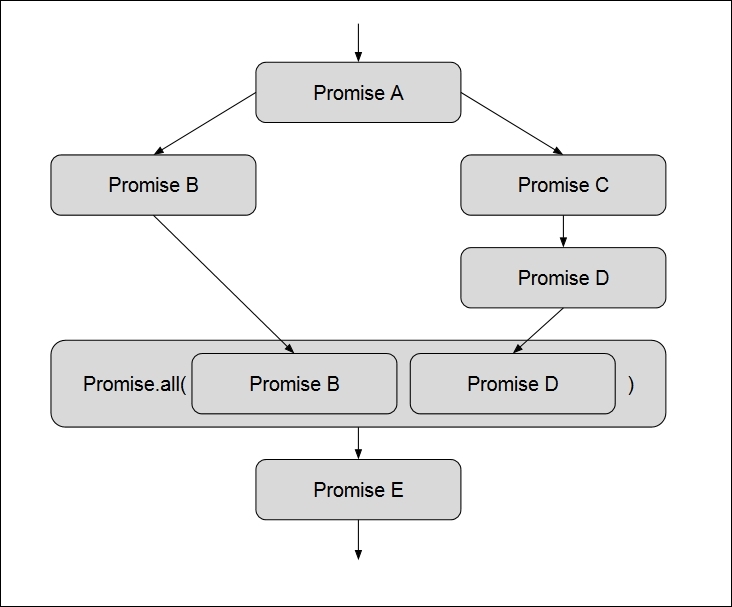Implementing Promise barriers with Promise.all()
You may find your application requires the use of promises in an all-or-nothing type of situation. That is, it will need to collectively evaluate a group of promises, and this collection will resolve as a single promise if and only if all of the contained promises are resolved; if any one of them is rejected, the aggregate promise will be rejected.
Note
The code, links, and a live example of this are available at .
How to do it...
The Promise.all() method accepts an iterable collection of promises (for example, an array of Promise objects or an object with a number of promise properties), and it will attempt to resolve all of them as a single aggregate promise. The parameter of the aggregate resolved handler will be an array or object that matches the resolved values of the contained promises:
var outerResolveA, outerResolveB; const promiseA = new Promise((resolve, reject) => { outerResolveA = resolve; }); const promiseB = new Promise((resolve, reject) => { outerResolveB = resolve; }); const multiPromiseAB = Promise.all([promiseA, promiseB]) .then((values) => console.log(values)); outerResolveA(123); outerResolveB(456); // [123, 456] If any of the promises in the collection are rejected, the aggregate promise will be rejected. The parameter of the aggregate rejected handler will be the returned value of the rejected promise:
var outerResolveC, outerRejectD; const promiseC = new Promise((resolve, reject) => { outerResolveC = resolve; }); const promiseD = new Promise((resolve, reject) => { outerRejectD = reject; }); const multiPromiseCD = Promise.all([promiseC, promiseD]) .then( values => console.log(values), rejectedValue => console.error(rejectedValue)); // resolve a collection promise, no handler execution outerResolveC(123); // reject a collection promise, rejection handler executes outerRejectD(456); // (error) 456 How it works...
As demonstrated, the aggregate promise will reach the final state only when all of the enclosed promises are resolved, or when a single enclosed promise is rejected. Using this type of promise is useful when the collection of promises do not need to reason about one another, but collective completion is the only metric of success for the group.
In the case of a contained rejection, the aggregate promise will not wait for the remaining promises to complete, but those promises will not be prevented from reaching their final state. Only the first promise to be rejected will be able to pass rejection data to the aggregate promise rejection handler.
There's more...
Promise.all() is in many ways extremely similar to an operating-system-level process synchronization barrier. A process barrier is a common point in the thread instruction execution that a collection of processes will reach independently and at different times, and no process can proceed further until all have reached this point. In the same way, Promise.all() will not proceed unless either all of the contained promises have been resolved—reached the barrier—or a single contained rejection will prevent that state from ever being achieved, in which case the failover handler logic will take over.
Since Promise.all() allows you to have a recombination of promises, it also allows your application's Promise chains to become a directed acyclic graph (DAG). The following is an example of a promise progression graph that diverges first and converges later:

This level of complexity is uncommon, but it is available for use should your application require it.
See also
- Creating Promise Wrappers with Promise.resolve() and Promise.reject() demonstrates how to use the core Promise utilities
- Canceling asynchronous actions with Promise.race() guides you through the implementation of a zero-failure-tolerant Promise system

